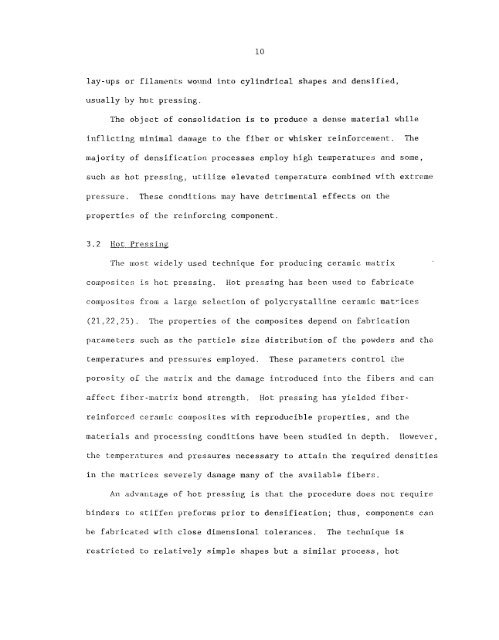Characterization and control of the fiber-matrix interface in ceramic ...
Characterization and control of the fiber-matrix interface in ceramic ...
Characterization and control of the fiber-matrix interface in ceramic ...
You also want an ePaper? Increase the reach of your titles
YUMPU automatically turns print PDFs into web optimized ePapers that Google loves.
10<br />
lay-ups or filaiiients wound <strong>in</strong>to cyl<strong>in</strong>drical shdpes <strong>and</strong> densified,<br />
usually hy hpt press<strong>in</strong>g.<br />
The object <strong>of</strong> consolidation is to produce a dense material while<br />
<strong>in</strong>flict<strong>in</strong>g m<strong>in</strong>imal damage to <strong>the</strong> <strong>fiber</strong> or whisker re<strong>in</strong>forcement.<br />
The<br />
majority <strong>of</strong> densification processes employ high temperatures <strong>and</strong> some,<br />
such as hot press<strong>in</strong>g, utilize elevated temperature comb<strong>in</strong>ed with extreme<br />
pressui-e.<br />
These condi t i o m nay have detrimental effects on <strong>the</strong><br />
propertie4 <strong>of</strong> <strong>the</strong> re<strong>in</strong>forc<strong>in</strong>g component.<br />
3.2 Hot Press<strong>in</strong>g<br />
The <strong>in</strong>ost widely used technique ~ O K produc<strong>in</strong>g <strong>ceramic</strong> <strong>matrix</strong><br />
co<strong>in</strong>posi tes is hot press<strong>in</strong>g.<br />
Hot press<strong>in</strong>g has been used to fabricate<br />
composites from a large selection <strong>of</strong> polycrystall<strong>in</strong>e <strong>ceramic</strong> matvices<br />
(21,32,35). The properties <strong>of</strong> <strong>the</strong> composites depend on fabrication<br />
parameters such as <strong>the</strong> particle size distribution <strong>of</strong> <strong>the</strong> powders <strong>and</strong> <strong>the</strong><br />
temperatures <strong>and</strong> pressures employed.<br />
These pdrameters <strong>control</strong> <strong>the</strong><br />
porosity OL <strong>the</strong> <strong>matrix</strong> <strong>and</strong> <strong>the</strong> damage <strong>in</strong>troduced <strong>in</strong>to <strong>the</strong> <strong>fiber</strong>s <strong>and</strong> can<br />
affect f iber-<strong>matrix</strong> bond strength.<br />
Hot press<strong>in</strong>g has yieldpd <strong>fiber</strong>-<br />
re<strong>in</strong>forced <strong>ceramic</strong> composites with reproducible properties, <strong>and</strong> <strong>the</strong><br />
materials <strong>and</strong> process<strong>in</strong>g conditions have been studied <strong>in</strong> depth.<br />
However,<br />
<strong>the</strong> tcmper,?tures <strong>and</strong> pressores necessary to atta<strong>in</strong> <strong>the</strong> required densities<br />
<strong>in</strong> <strong>the</strong> matrices severely damage many <strong>of</strong> <strong>the</strong> available <strong>fiber</strong>s.<br />
An advantage <strong>of</strong> hot press<strong>in</strong>g is that <strong>the</strong> procedure does not require<br />
b<strong>in</strong>ders 1-0<br />
stiffen preforms prior to densification; thus, components can<br />
be fabricated with close dimensional tIolerances,<br />
The technique is<br />
restricted to relatively simple shapes but a similar process, hot

















